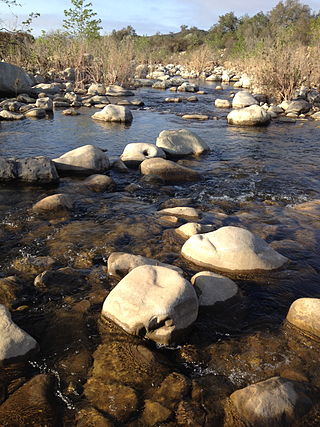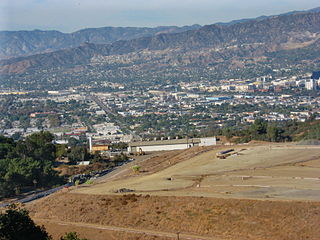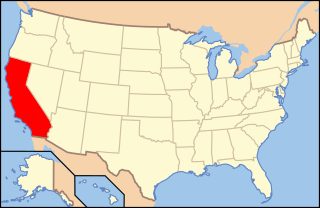Related Research Articles

Water pollution is the contamination of water bodies, usually as a result of human activities, so that it negatively affects its uses. Water bodies include lakes, rivers, oceans, aquifers, reservoirs and groundwater. Water pollution results when contaminants mix with these water bodies. Contaminants can come from one of four main sources: sewage discharges, industrial activities, agricultural activities, and urban runoff including stormwater. Water pollution is either surface water pollution or groundwater pollution. This form of pollution can lead to many problems, such as the degradation of aquatic ecosystems or spreading water-borne diseases when people use polluted water for drinking or irrigation. Another problem is that water pollution reduces the ecosystem services that the water resource would otherwise provide.

The Santa Clara River is an 83 mi (134 km) long river in Ventura and Los Angeles counties in Southern California. It drains parts of four ranges in the Transverse Ranges System north and northwest of Los Angeles, then flows west onto the Oxnard Plain and into the Santa Barbara Channel of the Pacific Ocean.

The Southern California Bight is a 692-kilometer-long stretch of curved coastline that runs along the west coast of the United States and Mexico, from Point Conception in California to Punta Colonet in Baja California, plus the area of the Pacific Ocean defined by that curve. This includes the Channel Islands of California and the Coronado Islands and Islas de Todo Santos of Baja California.

The Metropolitan Water District of Southern California is a regional wholesaler and the largest supplier of treated water in the United States. The name is usually shortened to "Met," "Metropolitan," or "MWD." It is a cooperative of fourteen cities, eleven municipal water districts, and one county water authority, that provides water to 19 million people in a 5,200-square-mile (13,000 km2) service area. It was created by an act of the California State Legislature in 1928, primarily to build and operate the Colorado River Aqueduct. Metropolitan became the first contractor to the State Water Project in 1960.

The California State Coastal Conservancy is a non-regulatory state agency in California established in 1976 to enhance coastal resources and public access to the coast. The CSCC is a department of the California Natural Resources Agency. The agency's work is conducted along the entirety of the California coast, including the interior San Francisco Bay and is responsible for the planning and coordination of federal land sales to acquire into state land as well as award grant funding for improvement projects. The Board of Directors for the agency is made up of seven members who are appointed by the Governor of California and approved by the California Legislature, members of the California State Assembly and California State Senate engage and provide oversight within their legislative capacity.

The Ventura River, in western Ventura County in southern California, United States, flows 16.2 miles (26.1 km) from its headwaters to the Pacific Ocean. The smallest of the three major rivers in Ventura County, it flows through the steeply sloped, narrow Ventura Valley, with its final 0.7 miles (1.1 km) through the broader Ventura River estuary, which extends from where it crosses under a 101 Freeway bridge through to the Pacific Ocean.

The Oxnard Plain is a large coastal plain in southwest Ventura County, California, United States surrounded by the mountains of the Transverse ranges. The cities of Oxnard, Camarillo, Port Hueneme and much of Ventura as well as the unincorporated communities of Hollywood Beach, El Rio, Saticoy, Silver Strand Beach, and Somis lie within the over 200-square-mile alluvial plain (520 km2). The population within the plain comprises a majority of the western half of the Oxnard-Thousand Oaks-Ventura Metro Area and includes the largest city along the Central Coast of California. The 16.5-mile-long coastline (26.6 km) is among the longest stretches of continuous, linear beaches in the state.

The Toyon Canyon Landfill is located within Griffith Park in the Los Feliz hillside neighborhood of greater Hollywood in central Los Angeles, California in the Santa Monica Mountains. The landfill began filling in 1957 and ended in 1985. A lawsuit in 1959 attempted to stop the project but was unsuccessful. There was a move in the 1980s to expand the landfill into Royce's Canyon to the northwest, but that was defeated.
The South Coast Air Quality Management District, also using the acronym South Coast (AQMD), formed in 1976, is the air pollution agency responsible for regulating stationary sources of air pollution in the South Coast Air Basin and the Coachella Valley portion of the Salton Sea Air Basin, in Southern California. The separate California Air Resources Board is responsible for regulating mobile sources (e.g. vehicles) in the air basin.
The Water Resources Development Act of 1992, Pub. L.Tooltip Public Law 102–580, was enacted by Congress of the United States on October 31, 1992. Most of the provisions of WRDA 1992 are administered by the United States Army Corps of Engineers.

The environment of California describes results of human habitation of the American State of California.
The Council for Watershed Health (CWH) is a nonprofit environmental organization in the U.S. state of California. It was founded in 1996 by Dorothy Green to preserve, restore, and enhance the Los Angeles and San Gabriel River watersheds. To accomplish this, it has brought together representatives from the regional water agencies, as well as government regulatory agencies ; community and environmental citizen groups; and businesses in the Los Angeles Basin watershed.

The California State Water Resources Control Board (SWRCB) is one of six branches of the California Environmental Protection Agency.
The Coastal and Marine Institute Laboratory (CMIL), formerly known as the Coastal Waters Laboratory, is an academic laboratory operated by the College of Sciences of San Diego State University (SDSU), in the Point Loma district of San Diego, California.

Water resource policy, sometimes called water resource management or water management, encompasses the policy-making processes and legislation that affect the collection, preparation, use, disposal, and protection of water resources. The long-term viability of water supply systems poses a significant challenge as a result of water resource depletion, climate change, and population expansion.
Los Angeles County Flood Control District v. Natural Resources Defense Council, Inc., 568 U.S. 78 (2013), is a United States Supreme Court case in which the Natural Resources Defense Council and Santa Monica Baykeeper challenged the Los Angeles County Flood Control District (District) for violating the terms of its National Pollutant Discharge Elimination System (NPDES) permit as shown in water quality measurements from monitoring stations within the Los Angeles and San Gabriel Rivers. The Supreme Court, by a unanimous 9-0 vote, reversed and remanded the Ninth Circuit's ruling on the grounds that the flow of water from an improved portion of a navigable waterway into an unimproved portion of the same waterway does not qualify as a "discharge of a pollutant" under the Clean Water Act.

The Groundwater Ambient Monitoring and Assessment Program (GAMA) is an all-inclusive monitoring program for groundwater that was implemented in 2000 in California, United States. It was created by the California State Water Resources Control Board as an improvement from groundwater programs that were already in place.
The Huntington Beach Desalination Plant is a 50-million-US-gallon per day (190 Ml) facility proposed by Poseidon Resources Corporation in Huntington Beach, California. The desalination plant is scheduled to be operational by 2023 at a site adjacent to the AES Huntington Beach Power Station. The plant will provide additional water for Orange County and reduce the county’s reliance on imported supplies.
During the 20th century a large amount of chemical waste was dumped into the Pacific Ocean off Southern California. Dumped materials include DDT, WW II munitions, radioactive waste, PCBs, petroleum products, and sulfuric acid.
References
- ↑ US Congress, Office of Technology Assessment (1987). Wastes in Marine Environments. Washington, DC: US Government Printing Office. ISBN 0-89116-793-5
- ↑ Sharpsteen, Bill (2010). Dirty Water: One Man's Fight to Clean Up One of the World's Most Polluted Bays. Berkeley and Los Angeles, CA: University of California Press. ISBN 978-0-520-25660-6
- ↑ Committee on Reducing Stormwater Discharge Contributions to Water Pollution, National Research Council (2009). Urban Stormwater Management in the United States. Washington, DC: The National Academies Press. p. 512. ISBN 978-0-309-12539-0
- ↑ Committee on a Systems Assessment of Marine Environmental Monitoring, National Research Council (1990). Managing Troubled Waters: The Role of Marine Environmental Monitoring. Washington, DC: National Academy Press. p. 22. ISBN 0-309-04194-5
- ↑ Panel on Southern California Bight of the Committee on a Systems Assessment of Marine Environmental Monitoring (1990). Monitoring Southern California's Coastal Waters. Washington, DC: National Academy Press. p. 90-91. ISBN 0-309-04327-1
- ↑ Soule, Dorothy F. and Don Walsh (1983). Waste disposal in the oceans: minimizing impact, maximizing benefits. Boulder, CO: Westview Press. ISBN 0-86531-966-9
- ↑ Sercu, Bram (July 27, 2012). "Eye on the Environment: Clean beach measuring to improve". Ventura County Star .
- ↑ Mearns, Alan J; Allen, M James; Moore, Michael D (2001), S.B. Weisberg; D. Elmore (eds.), The Southern California Coastal Water Research Project - 30 years of environmental research in the Southern California Bight (PDF), Southern California Coastal Water Research Project 1999-2000 Annual Report, Westminster, CA.: Southern California Coastal Water Research Project, pp. 2–26, retrieved May 5, 2014
- ↑ Wick, Gerald (July 1973). “California’s Outfalls.” New Scientist 59(854): 94-95.
- ↑ Kennish, Michael J (1998). Pollution Impacts on Marine Biotic Communities. Boca Raton, FL: CRC Press. p. 151-152. ISBN 0-8493-8428-1